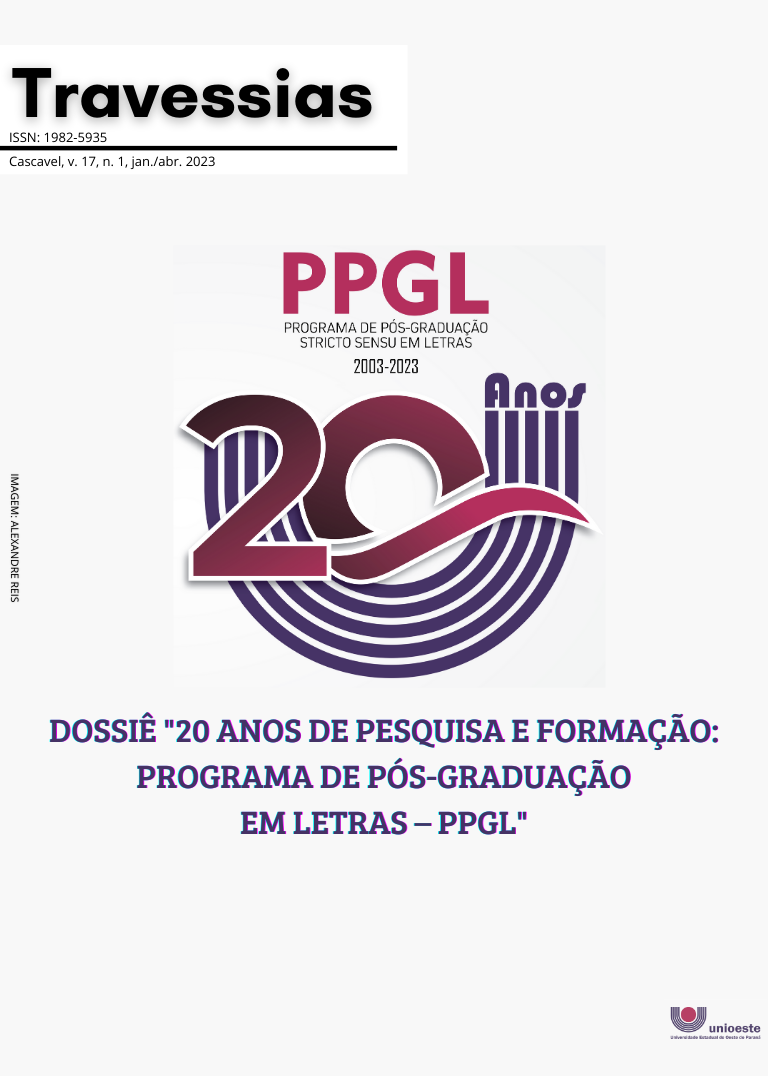“O homem da areia” de E.T.A. Hoffmann
o inquietante como categoria estética
DOI:
https://doi.org/10.48075/rt.v17i1.30544Palavras-chave:
Inquietante, E.T.A. Hoffmann, Romantismo alemão, Sigmund FreudResumo
O artigo tem como objetivo reconhecer o motivo do inquietante como uma categoria estética fundamental no universo romântico, especialmente na obra “O homem da areia” de E.T.A. Hoffmann. A hipótese central deste trabalho é que o fenômeno do inquietante, no que diz respeito à leitura do texto de Hoffmann, tem sido interpretado de forma restrita pela tradição psicanalítica. Para alcançar esse objetivo, em primeiro lugar será proposto uma caracterização provisória do inquietante como categoria estética; em seguida será apresentado uma visão geral sobre o assunto baseado no conto “O homem da areia”; na terceira parte será exposto a interpretação psicanalítica do inquietante de Sigmund Freud em contraste com a proposta de Ernst Jentsch; e por último, será abordada a tarefa de uma poética do inquietante. O universo poético dos românticos alemães é caracterizado por tornar evidente um mundo interior marcado com matizes claro-escuro, onde a obra literária tenta mostrar o que nem sempre é visível.
Downloads
Referências
BEHLER, Ernst. German Romantic Literary Theory. Cambridge: Cambridge University Press, 2005.
BERLIN, Isaiah. As raízes do romantismo. São Paulo: Três estrellas, 2015.
BLOOM, Harold. The Western Canon: The Books and School of the Ages, New York: Riverhead Books, 1995.
CARRASCO, Ana. Lo siniestro enroscado a la Palabra. Lenguaje y extrañamiento a partir de la lectura de Lo siniestro de Freud, Espéculo. Revista de estudios literarios, n. 33, 2006. https://webs.ucm.es/info/especulo/numero33/siniestr.html
FREUD, Sigmund. Das Unheimliche. In: Gesammelte Werke. Vol. XII. Frankfurt am Main: Fischer Verlag, p. 227-278, 1999.
FREUD, Sigmund. O estranho (1919). In: Edição standard brasileira das obras psicológicas completas de Sigmund Freud. Vol. XVII. Rio de Janeiro: Imago, p. 275-314, 1996.
FREUD, Sigmund. O incômodo. São Paulo: Blucher, 2021.
FREUD, Sigmund. O infamiliar / Das Unheimliche (1919). In: Obras incompletas de Sigmund Freud. Belo Horizonte: Autêntica, p. 27-126, 2019.
FREUD, Sigmund. O inquietante (1919). In: Obras Completas. Vol. 14. São Paulo: Companhia da Letras, p. 329-376, 2010.
INGARDEN, Roman. Das literarische Kunstwerk. Eine Untersuchung aus dem Grenzgebiet der Ontologie, Logik und Literaturwissenschaft, Halle: Max Niemeyer, 1931.
JENTSCH, Ernst. Zur Psychologie des Unheimlichen. Psychiatrisch-Neurologische Wochenschrift. n 22; p. 195-198; n 23, p. 203-205, 1906. https://d-nb.info/1138447315/34
KANT, Immanuel. Observações sobre o sentimento do belo e do sublime. Campinas: Papirus Editora, 2000.
KANT, Immanuel. Kritik der reinen Vernunft. Hamburg: Felix Meiner Verlag, 2003.
KOFMAN, Sarah. Cuatro novelas analíticas, Buenos Aires: Treib, 1978.
KREMER, Detlef. Freuds Aufsatz Das Unheimliche und die Widerstände des unverständlichen Textes. In: Peter-André Alt; Thomas Anz (Eds.). Sigmund Freud und das Wissen der Literatur. Berlin/New York: Walter de Gruyter, p. 59-72, 2008.
NOVALIS. Werke. München: Beck, 2001.
RANK, Otto. Der Doppelgänger. Eine psychoanalytische Studie, Wien: Turia & Kant, 1993.
RUCKERT, Gerhard. Volksmärchen und Kunstmärchen. In: Dinges, Ottilie; Born, Monika; Janning, Jürgen (Eds.). Märchen in Erziehung und Unterricht. Kassel: Röth, p. 158-162, 1986.
SANDERS, Daniel. Wörterbuch der deutschen Sprache. Leipzig: Verlag von Otto Wigand, 1859-1865.
SCHELLING, Friedrich Wilhelm Joseph. Philosophie der Mythologie. Stuttgart-Augsburg: J. G. Cotta, 1857.
SCHLEGEL, Friedrich. O dialeto dos fragmentos. São Paulo: Iluminuras, 1997.
SERRANO, Vicente. Soñando monstruos. Terror y delirio en la modernidad. Madrid: Plaza y Valdés Editores, 2010.
SOUZA, Paulo César de. As palavras de Freud: o vocabulário freudiano e suas versões. São Paulo: Companhia das Letras, 2010.
TODOROV, Tzvetan. Introdução à Literatura Fantástica. São Paulo: Perspectiva, 2004.
TODOROV, Tzvetan. As estruturas narrativas. São Paulo: Editora Perspectiva, 2013.
TRÍAS, Eugenio. Lo Bello y lo Siniestro. Barcelona: Debolsillo, 2011.
TÜRK, Johannes. Freuds Immunologien des Psychischen. Poetica: Zeitschrift für Sprach- und Literaturwissenschaft, n. 38, p. 167-188, 2006. DOI: https://doi.org/10.30965/25890530-0380102007
ZILBERMAN, Regina. Estética da recepção e história da literatura. São Paulo: Ática, 2009.
Downloads
Publicado
Como Citar
Edição
Seção
Licença
Copyright (c) 2023 Autores mantêm os direitos autorais e concedem à revista o direito de primeira publicação, com o trabalho simultaneamente licenciado sob CC-BY-NC-SA 4.0 que permite o compartilhamento do trabalho com indicação da autoria e publicação inicial nesta revista

Este trabalho está licenciado sob uma licença Creative Commons Attribution-NonCommercial-ShareAlike 4.0 International License.
Aviso de Direito Autoral Creative Commons
Política para Periódicos de Acesso Livre
Autores que publicam nesta revista concordam com os seguintes termos:
1. Autores mantêm os direitos autorais e concedem à revista o direito de primeira publicação, com o trabalho simultaneamente licenciado sob a Licença Creative Commons Attribution que permite o compartilhamento do trabalho com reconhecimento da autoria e publicação inicial nesta revista.
2. Autores têm autorização para assumir contratos adicionais separadamente, para distribuição não-exclusiva da versão do trabalho publicada nesta revista (ex.: publicar em repositório institucional ou como capítulo de livro), com reconhecimento de autoria e publicação inicial nesta revista.
3. Autores têm permissão e são estimulados a publicar e distribuir seu trabalho online (ex.: em repositórios institucionais ou na sua página pessoal) a qualquer ponto antes ou durante o processo editorial, já que isso pode gerar alterações produtivas, bem como aumentar o impacto e a citação do trabalho publicado (Veja O Efeito do Acesso Livre).
Licença Creative Commons
Esta obra está licenciada com uma Licença Creative Commons Atribuição-NãoComercial-CompartilhaIgual 4.0 Internacional, o que permite compartilhar, copiar, distribuir, exibir, reproduzir, a totalidade ou partes desde que não tenha objetivo comercial e sejam citados os autores e a fonte.



